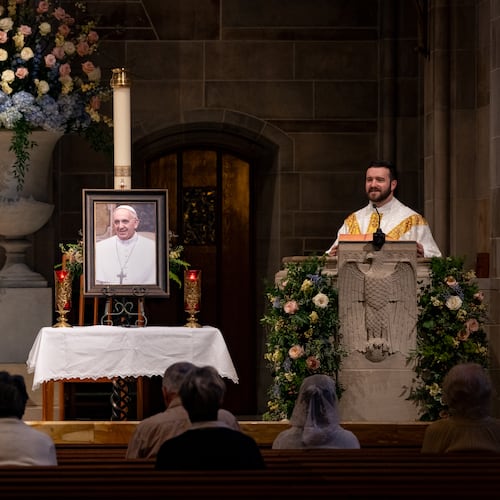The 71-year-old mayor of Mexico Beach halted awestruck beside the crushed remains of his hardware store.
A pair of parasailers glided high above, towed by a boat zipping along the Florida Gulf Coast town’s nearly vacant beach. They were the first Al Cathey had seen since October, when Hurricane Michael shredded parts of the Panhandle and nearly obliterated his community.
“How about that,” he said, watching the floating shapes. “We don’t have hardly anybody here. That’s cool to see somebody up there. Good for them.”
» RELATED | Is a Hurricane Michael relief deal finally on the horizon?
» FROM 2018 | Hurricane Michael damage is 'phenomenal'
Most tourists from Atlanta descending on northwest Florida’s beaches this Memorial Day won’t see many reminders of Michael, one of only four known Category 5 hurricanes to make U.S. landfall. Popular vacation spots from Pensacola Beach to Destin to Seaside are in good shape, having escaped the worst of the storm. Even much of Panama City Beach looks relatively normal again despite some crooked poles, shredded trees and bashed signs.
Travel along the less-visited stretch of coast between Panama City and Mexico Beach, though, where Michael made landfall, and the destruction is ever present. Recovery has come in only small doses. Residents say full restoration will take years and worry they have been forgotten even as the U.S. Senate this week revisits an oft-delayed disaster relief package.
Thousands of displaced residents — possibly tens of thousands — have moved away, at least temporarily. Others have jumped from one temporary home — or tent or camper or trailer — to the next. And the next hurricane season begins June 1.
“We talk to friends up north and they say, ‘Everything is OK, right?’” said Amy Carter, a third-grade teacher in Bay County who sleeps with a bucket beside her bed to catch leaks from her unrepaired roof.
» RELATED | How Hurricane Michael made history
» FROM 2018 | Hurricane Michael in Georgia: Damage by the numbers
Parts of her house in Panama City are gone. So are parts of the church building where her husband is a minister.
When it rains hard and thunder rumbles, a couple students in Carter’s class will look around nervously, remembering what it was like to ride out Michael.
“I walk by and put my hand on their shoulder and say, ‘It’s OK. You’re safe.’”
`Like a war zone’
Thousands of truckloads of debris — nearly 33 million cubic yards — have been hauled away in Florida. Some crushed homes have been demolished. Downed street signs, traffic signals and power lines have been repaired.
Some $1.2 billion in federal funds have been spent on Michael response and recovery efforts in the state. More than 31,000 households were approved for assistance, according to the Federal Emergency Management Agency, and the Small Business Administration OK’d more than $600 million in loans, most of it to homeowners and renters.
Yet months of debris removal work remain. Some homes and buildings in tiny Mexico Beach still teeter on pillars or have walls half peeled off. Repairs are forcing a detour off parts of the main highway through town.
At nearby Tyndall Air Force Base, an important local economic hub, all permanent on-base homes were damaged and remain vacant. The number of active duty military personnel has been cut by nearly 1,000. In Panama City, church steeples are still toppled, buildings are crushed, chimneys are gone and tarped roofs create a new color scheme for the city: a patchwork of blue.
“It’s been like a war zone the first few months,” said Bay County Commissioner Philip “Griff” Griffitts, one of three on the five-member board displaced from their homes.
Much of the destruction is hidden. A quick glance down the cul-de-sac in the golf-course community where Griffitts lived on the fringes of Panama City Beach reveals nothing amiss. Yet several of the houses remain empty. Their roofs have been replaced, but much of their interiors are gutted, some after water led to black mold.
Bay County officials are budgeting for a 10% decline in property tax revenue. Many residents complain about insufficient federal assistance. The $18.5 million FEMA has provided to Bay County so far is a fraction of the county’s costs for debris removal alone.
Griffitts recently bought another home after moving six other times to temporary quarters following the storm.
He estimates 20,000 people have left Bay County, which previously had a population of 180,000. Local leaders worry that next year’s once-in-a-decade census count will miss many displaced people. That could affect federal funding locally for a decade.
“We’re not coming back,” said David Yates.
A native of the Florida Panhandle, Yates, his wife and eight-year-old daughter evacuated to be with his in-laws in metro Atlanta. The home the family rented in Panama City wasn’t badly damaged. Uncertainty about the area’s recovery and concerns about looting and violence in Michael’s immediate wake quickly convinced them to make the move permanent.
About 68% of Bay County residences were significantly damaged or destroyed, according to local authorities. Apartment units and other rentals were particularly hard hit. As supply constricted, landlords jacked up rent, sometimes ousting lower paying tenants in the process, locals say.
Homeowners complain about insurance companies failing to pay for the true cost of repairs, and soaring rates charged by construction contractors with poorly trained workers and work backlogs of a year or longer.
Katelin Griffith, a surgical assistant at a local hospital that shut down for weeks due to storm damage, got tired of waiting. She and her husband hired an attorney to deal with their insurance company. The couple in Callaway also sealed off parts of their three-bedroom home where mold grew, turned off the heating and air conditioning systems to avoid spreading tainted air and began ripping out water-damaged materials.
» CAPITOL RECAP | Hurricane Michael remains a divisive force in Georgia
They and their daughters, eight and two years old, sleep in the living room. Their belongings are stashed in a storage pod in the driveway.
“I didn’t think we’d still be dealing with this,” Griffith said.
It’s that way with a lot of things. Like fixing their car, which had been dented by the hurricane. Body shops are so backed up, the couple was told wait until September — nearly a year after Michael struck.
The constant turmoil has taken a toll on the community, said Sharon Michalik, a spokeswoman for Bay County’s public school system.
“People are exhausted. Kids are worn out. They’ve moved five or six times,” she said.
With post-storm enrollment down nearly 15%, the school system faced sharp budget cuts tied to funding formulas. Officials considered 600 employee layoffs before state legislators approved extra dollars.
Nearly 5,000 students are reported as having no fixed address and mental health problems have soared. More than 600 students have been referred for counseling with new mobile response teams.
Living in a tent
“What recovery?” said Diahnn “Shelly” Summers.
She and her retired husband invited locals displaced by the hurricane to live for free in tents beside the couple’s home 11 miles inland from Panama City. Dozens of people have cycled through since the storm. Eighteen people, including some families with children, live there now.
Amanda Bohn, her three young children and her husband, a landscaper, moved onto Summer’s property soon after a landlord evicted the family from a rented trailer earlier this year. Bohn said the trailer had been damaged from the storm and many of her belongings snatched by looters. But she said the landlord’s goal was to free the space for people who would pay more.
“If it wasn’t for Shelly, me and my husband and my kids probably would be sleeping under a bridge somewhere,” said Bohn, who received roughly $4,000 in federal disaster money.
Closer to Michael’s ground zero, Mexico Beach has removed a lot of debris, according to Cathey, the mayor. But “80% of our city was destroyed.”
Of roughly 2,700 living units, only about 400 remain, he said. A grocery store, gas station, two banks and several restaurants are gone. So is the town’s picturesque pier.
Crews only recently received federal approval for dune construction to provide some protection for the new hurricane season.
Cathey said he isn’t worried. “What is a hurricane going to do? What is it going to tear up? What’s left?”
Steven and Gail Dwyer, who both retired from the military, only recently moved back to the home they had built in Mexico Beach a year before the hurricane hit. Storm repairs cost more than $200,000. They say three neighbors died within 200 yards of their home.
Some of the couple’s cherished possessions had been found and returned by workers and strangers. A knife Steven had been given as the best man in his brother’s wedding and a watch that belonged to his father. A plaque that had been in Gail’s family for decades.
The Dwyers aren’t aware of anyone else to permanently return to the beach side of U.S. 98 in Mexico Beach. Officially, the water and sewer system hasn’t been turned back on in that part of the city, so the couple has a port-a-potty in the yard.
Gail plans to take the couple’s excitable dog, “Drama,” for regular walks to show passersby “a sense of normalcy,” she said. “Mexico Beach needs people to come back.”
About the Author
The Latest
Featured








